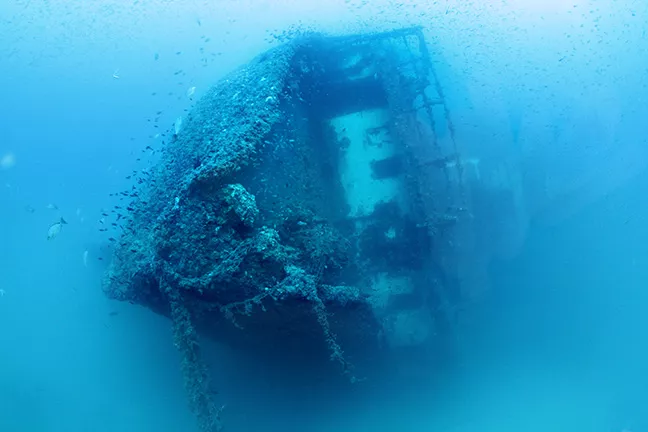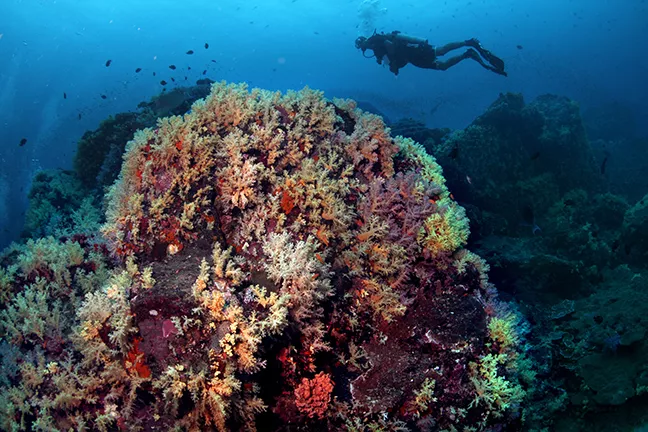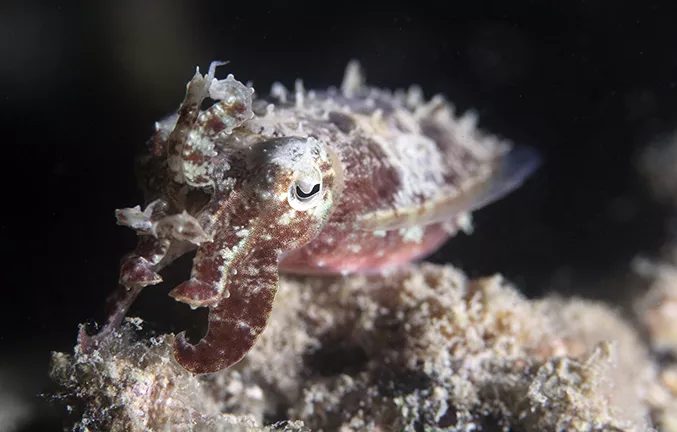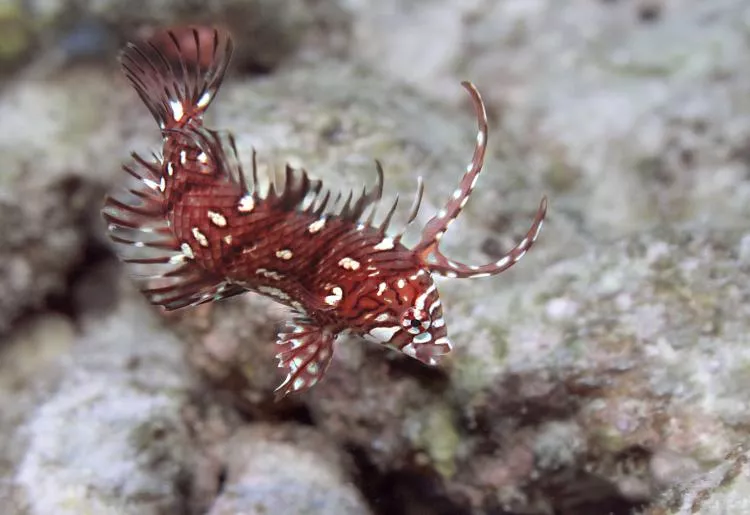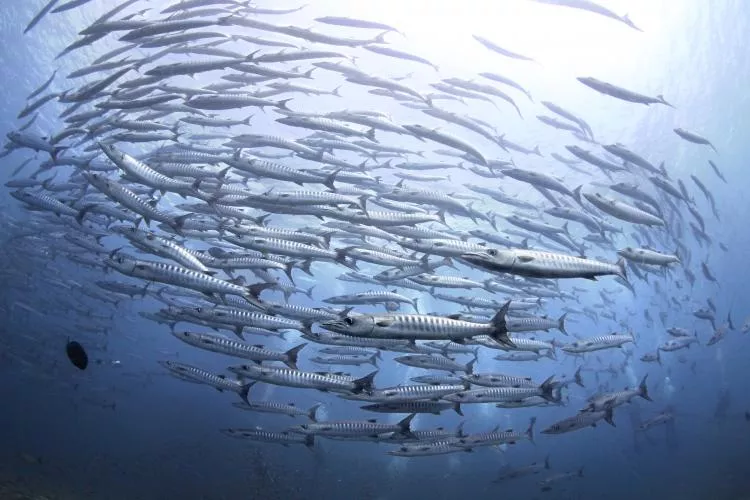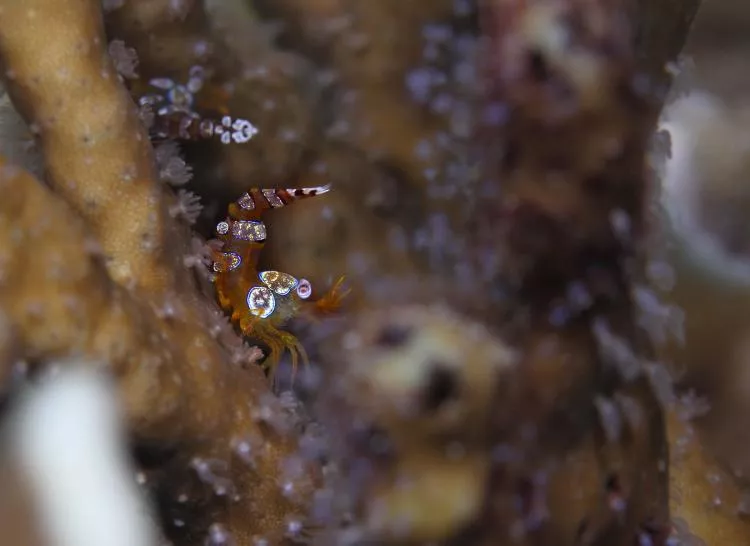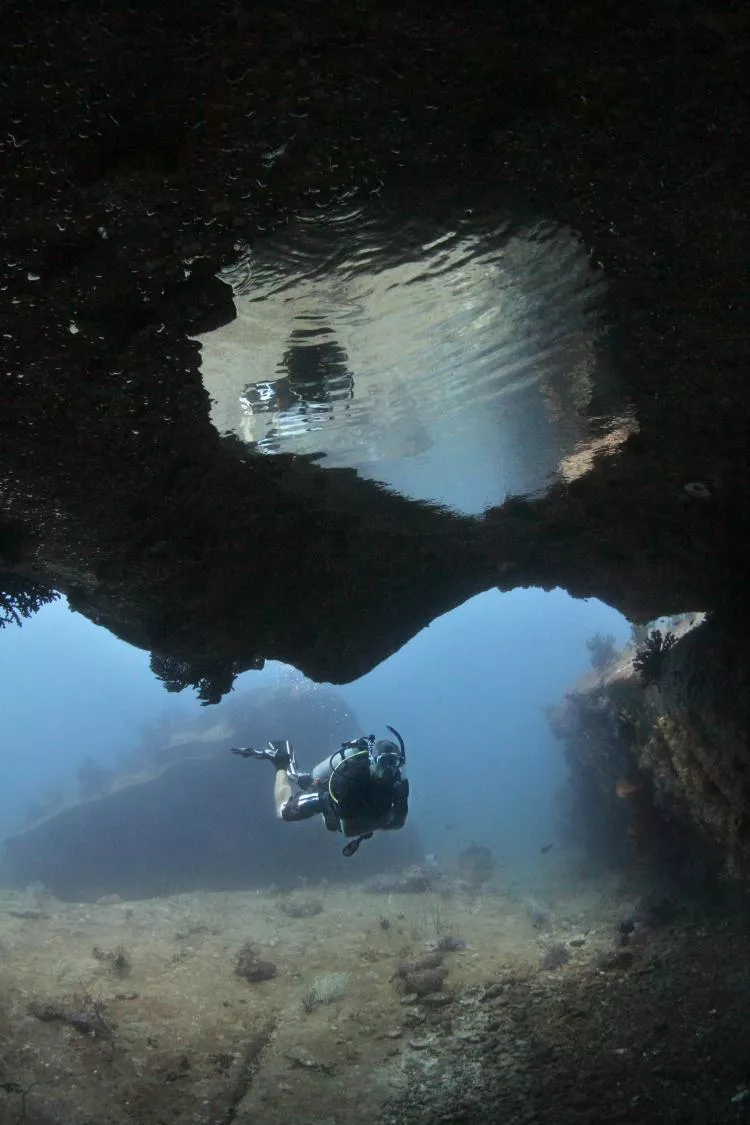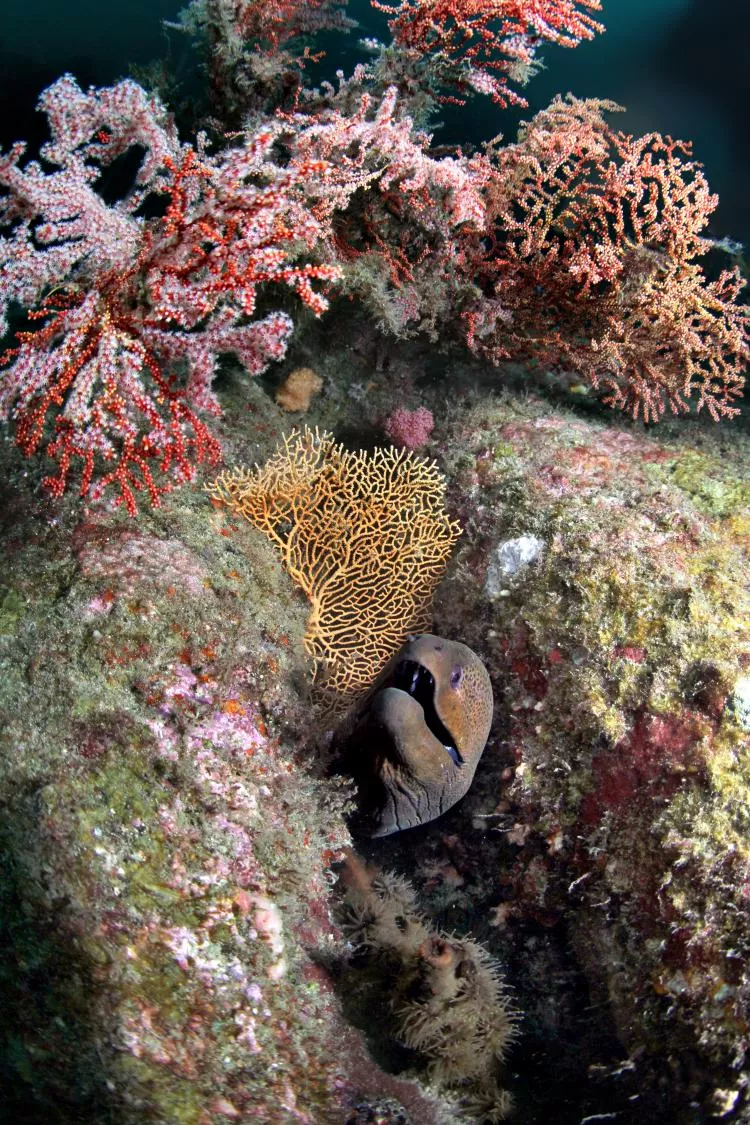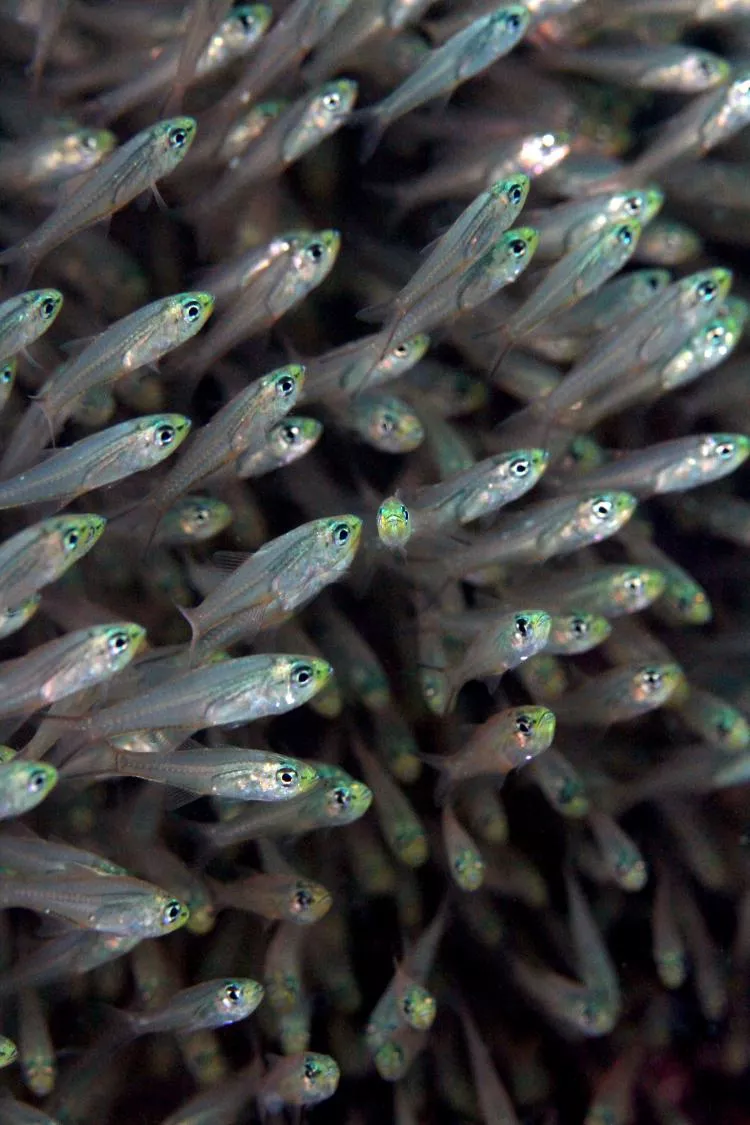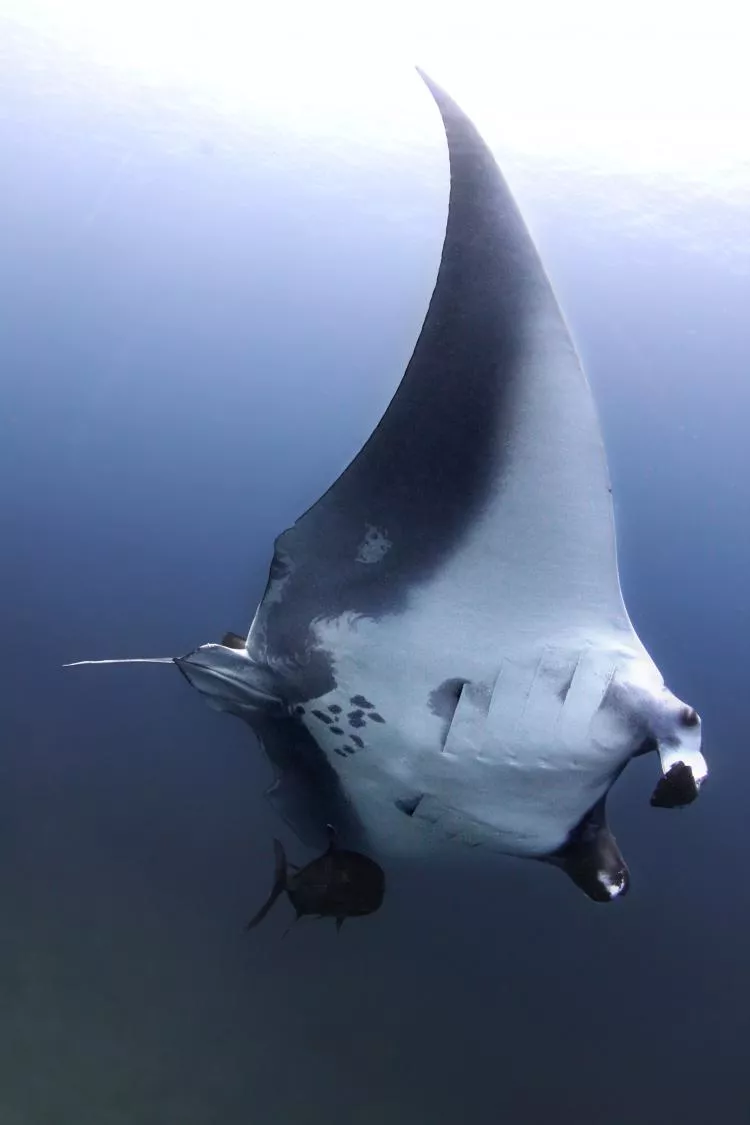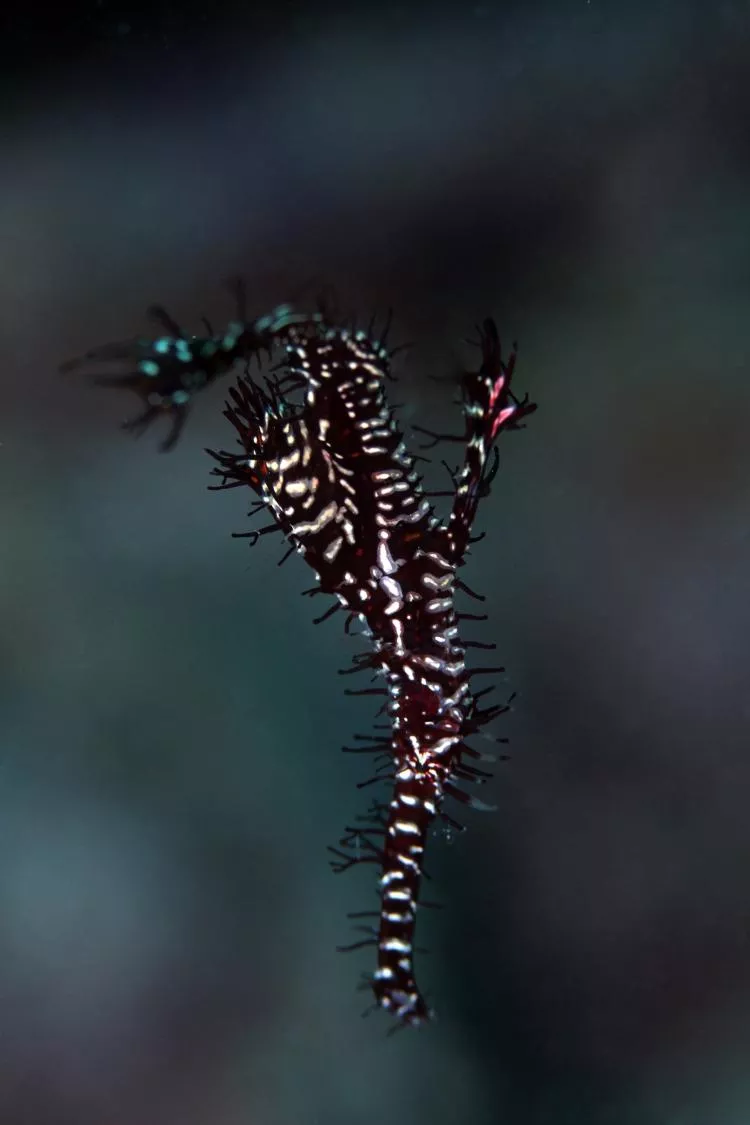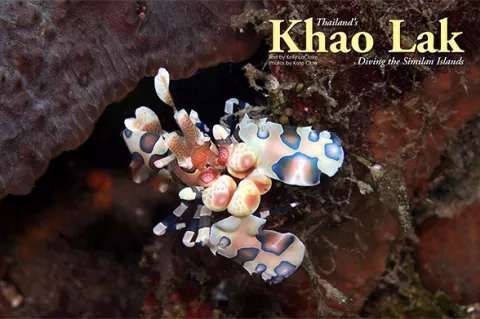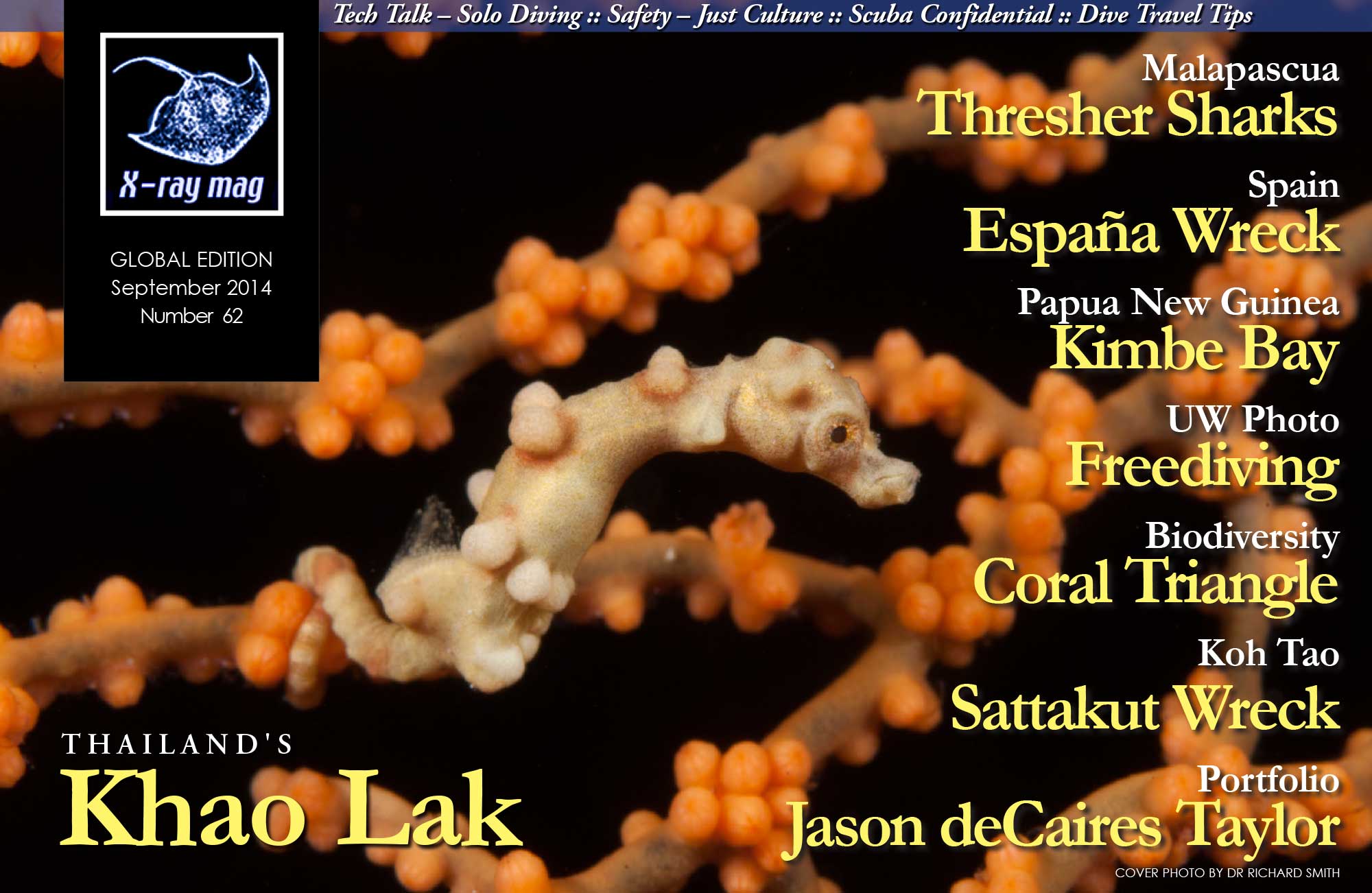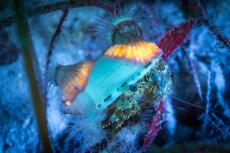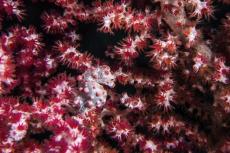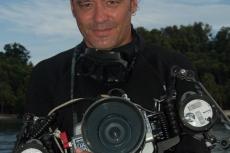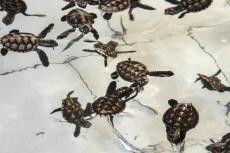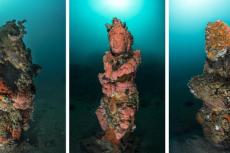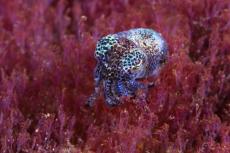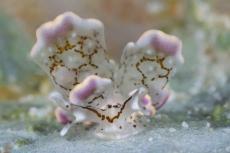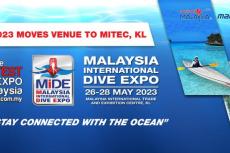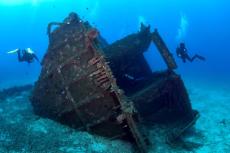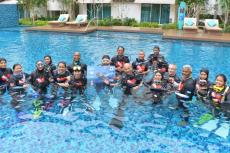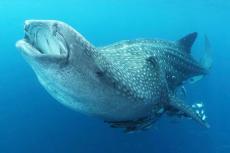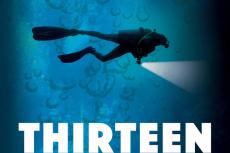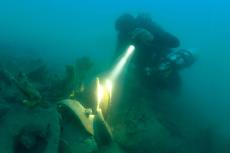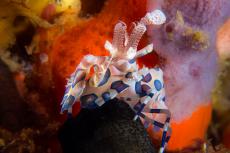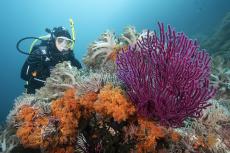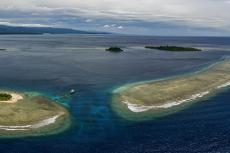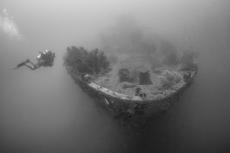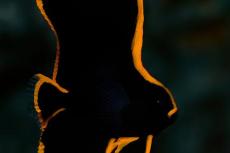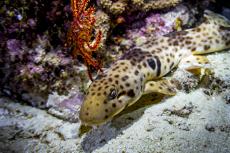My dive buddy, Kate, is trying to get a shot of a purple sea fan but she’s having trouble with her strobes and my ADD is kicking in. This happens occasionally. I try to be a good buddy, I really do, but there’s just so damn much to see underwater and I get antsy if we stop too long for a photograph.
Contributed by
This is the conversation I’m having with myself when I feel something tickle the back of my neck. It’s not physical—it’s more like a soft breath against my brain, a whispering ghost of premonition. I look up and my eyes widen as my heart begins to pound involuntarily. My mind goes quiet and time seems to slow down.
Khao Lak
I wasn’t even supposed to be in Thailand. Kate and I had just finished a two-week diving assignment in Indonesia and my flight back to the United States was already booked. My wife’s birthday was only a few days away and I needed to get home. But, as sometimes happens, fate intervened.
Just before leaving, Joquim Hedelin, a Swedish transplant and owner of Liquid Adventures, invited our team to tag along on a four-day liveaboard safari around the Similan Islands. Now you tell me, just how exactly does an avid diver say no to something like that?
So, that night I called my amazing wife and with her blessing (“You’d be silly to pass this up!” she said. “We can celebrate my birthday when you get back.”) I was flying with Kate to Thailand the next evening.
An hour-long taxi ride north of Phuket International Airport brought us to the bustling beachside village of Khao Lak. Since our boat didn’t leave for two days, we had plenty of time to take a look around and soak up the culture. Thailand is unique and captivating—a mash-up of third and first world cultures.
Scooters and overfilled tuk tuks weave precariously among high-end SUVs and Mercedes sedans on the same highways. IPods and blue-ray discs sit incongruously next to fly-riddled pig skins and barbequed crickets at the same outdoor markets. It’s a land of elephants and monkeys, jungles and temples, where the heat saps the life out of you and the natural beauty fills you up again.
But it’s the people that truly make Thailand so endearing. Thai folk are friendly and warm, shy but curious. Invite them into conversation and they respond with polite affection and ready humor. Each and every local I met I liked immediately and they seemed genuinely interested in the happiness of others.
After the devastation of the tsunami that wiped out the entire village in 2004, I had fully prepared myself for locals still mired in the suffering and pain of so much dissolution. But what I found were people smiling and living their lives with resilience and a seemingly unbreakable sprit.
Welcome aboard
It was to be my first trip on a liveaboard and I was feeling the anxious butterflies of anticipation. The boat crew, lithe men with quick movements, loaded our gear while the kitchen ladies welcomed us with friendly Thai greetings and broad smiles. After a quick tour of our new home, our group gathered on the foredeck for the departing ceremony.
Our captain and his family, who live on Liquid’s 26-meter dive boat for six months a year, set out food and gift offerings to Buddha on the bow and then asked for safe travels. Fireworks concluded the prayers, frightening away any evil spirits that may have been trying to stow away, and soon we were slipping out into the black night towards the Similan Islands.
The next morning, our little group of seven gulped down steaming mugs of coffee before hurrying to the stern to gear up, some of us with toast still in our mouths. For several of the guests, it was going to be the first dive in months and their excitement was infectious. One couple, who hadn’t been in the water for a year, couldn’t stop laughing while they raced to see who got ready the quickest.
Kate smiled at me while turning on my tank valve, “This is gonna be awesome.”
Similan Islands
The waters around the Similans are prolific and abounding. So much so, the Liquid crew aptly calls one dive site “Fish Soup,” an area so packed with massing snapper and juvenile barracuda that you literally get lost in the twisting swarms of sea life.
Our first site, Christmas Point, was surrounded by vast granite monoliths that towered over the sand and coral floor. Several groups of imposing trevally passed us as we finned among the giant boulders, eyeing us suspiciously like sentinels on patrol while a school of large sweetlips tried to hide under a rocky overhang.
Centuries of swift current and erosion have carved out numerous archways and long, cave-like swim throughs. Kate found one with a sizeable air pocket acting as a natural ceiling mirror and had me take a closer look while she readied her camera.
This is gonna be awesome.
I marvel at Kate in these situations. All I have to do is swim where she directs me and smile on cue. She, on the other hand, has a much more arduous task. Capturing a magazine-quality underwater image isn’t just difficult, it’s damned near impossible. That may sound far-fetched, loyal reader, but let me assure you it isn’t. Next time you’re diving, try the following and see how you do:
While holding a 30-pound camera, maintain perfect buoyancy even in swift current; direct your buddy with hand signals to get them into position and make sure the fish around you don’t move; manually adjust your flash strobes into the correct position and check that they will fire with just enough light. Now, look through your leaky mask, through the tiny, foggy housing and focus your camera perfectly (remember if you get this step or any of these steps wrong, your picture will be worthless). Now, simply hold your breath so your bubbles don’t get in the shot, conscientiously remembering to use only your fins to stay in exactly the same place without bumping into any coral around you and take the shot of a lifetime.
Liveaboard lifestyle
Back on the boat, the galley crew had prepared breakfast: omelets, fresh pineapple, spiced pancakes and watermelon wedges. Our group attacked it, swapping stories about the last dive between sips of coffee and juice.
“What’s next?” someone asked Joquim.
“Whatever you want,” he replied smiling. “You’re on holiday! Our next dive is scheduled in an hour and a half, but this is your vacation—make yourself at home and do as you please.”
This sums up the liveaboard experience for me. And for the next few days, our group fell into a blissful fog of utter contentment—passing our time napping, reading, eating, diving and then starting the whole process all over again. In a word, it was perfect and I didn’t want it to end.
Richelieu Rock
The Andaman Sea is famous for a fierce, bitterly cold current that rolls through it. Local divers call it the green monster on account of its unpredictable surges and pea soup consistency.
As I followed Kate off the stern and dropped with the swift current into the horseshoe-shaped reef of Richelieu Rock, I could see the emerald colored thermocline below us, rushing around the giant limestone pinnacle like an angry underwater sandstorm.
The tides around Richelieu Rock are densely packed with plankton and other nutrients, creating incredible biodiversity, making Thailand’s most coveted dive site the perfect place to see not only large pelagics but the smallest macro treats as well. And if you’re a photographer, probably your biggest challenge will be deciding which lens to use on each dive; chose the wrong one and a brief encounter with the occasional whale shark or a timid eagle ray can leave you slightly frustrated.
Kate had her macro lens on for this dive as one of guides had given us a map to a special rarity nesting at this site. We descended down into the frigid green monster and I immediately began cursing my decision to forgo a wetsuit. I gave Kate our “Holy mother of God—it’s frickin’ cold, so let’s hurry this up!” hand signal and we fought the current toward a small collection of boulders.
The viz gets sketchy in that tidal wave of freezing green water, but somehow Kate managed to find the right spot and we were soon watching two striking harlequin shrimp feeding on the broken leg of a blue starfish. I had never seen this particular species before, and in a moment, I had forgotten all about my trembling arms.
Harlequin shrimp seem to glow underwater as if they are constantly backlit by some hidden light source radiating inside their tiny little bodies. We watched them feeding for several minutes before Kate wrapped her arms around herself and shivered—Bbbrrrrrrr!
I nodded and we slowly finned upwards into warmer water, greeted by a cautious and hesitant cuttlefish. He flashed a multitude of changing color patterns, extending his middle two tentacles at me. “You see this?” he seemed to say, “This gesture means the same below water as it does on the surface, big guy. So why don’t you go back where you came from and leave me alone.”
I wasn’t too offended, I was intruding after all, and a quick look at my computer told me that my air was—shocker—running low anyway. So, we gave the guarded cephalopod an apologetic wave and headed up to our safety stop.
The Dome of Awesomeness
The single greatest day of diving in my life was spent at the island of Koh Tachai. Kate and I met on the top deck early to share a cup of tea and watch the sunrise before joining our friends for a light breakfast and morning briefing. The currents could be fast here, we were told, and as such, lots of nutrients swirl around this dive site, attracting all kinds of life, including manta rays. We were told that the last few groups had not seen any of the giant rays, and they might be gone for the year, but if we did have a chance at spotting them, this was going to be the place.
The group was buzzing as we slipped into our gear. A quick check among the guests revealed that most all of us had yet to see a manta in the wild and the prospect had each and every one of us nearly shaking with anticipation.
We weren’t three meters down the mooring line when a massive school of barracuda swam by us in a lazy, twisting cyclone. They were followed by a group of batfish and a leery pack of trevally.
The dive site came more into focus as we dropped and I could see a giant granite dome at the center of the site surrounded by coral heads and rocky outcroppings scattered along the sea bed. We leveled off at around 20 meters and were greeted by a large green moray hissing at a banded sea snake who was hunting too close the grumpy eel’s den.
Thousands of fusiliers swarmed the site and I was astounded at the amount of life making this island reef their home. There was so much activity and so many species to see my attention was being pulled in a hundred different directions at once. I turned to Kate and gave her a large “Are you kidding me?!” smile. She nodded furiously in agreement.
A curious hawksbill turtle glided by and we followed it for a few meters to a giant purple sea fan. It was here that Kate stopped for a photograph and my lack of attention span began to get the best of me. So far, this dive site had been amazing and the thought of missing anything was almost too much for me. Then the giant manta ray passed overhead and nothing else seemed to matter.
It was easily 15 feet from tip to tip, as big and alien as a flying saucer. The massive underbelly flashed gray and white while long, delicate gills rippled from its own wake. I was instantly mesmerized and my regulator almost fell out of my mouth, but somehow I managed to give Kate three soft taps on the shoulder.
Kate let out a shriek of surprise and shot off to get along side it, sea fan and buddy forgotten in her excitement. I generally don’t have too much trouble keeping up with her but this was different; she was gone in an instant and I was swimming as hard as I could just to keep her fins and the shadow of the giant ray in my sights. Thankfully, after only a minute, Kate came to a stop and the manta turned on its side, wings displayed in a vast, far reaching triangle, and swooped back towards us.
By now the whole group had seen it and they swiftly gathered in a loose semi circle to marvel at its elegance. Our guides had their hands held out, asking us to stay put lest we spook the gentle giant and chase it away. As it banked around us a second time, the manta gracefully fluttered its enormous wings and passed within touching distance of Kate and me.
The manta danced around us, swimming in wide dignified circles for the next few minutes while our wide-eyed group watched in delight. When my gauge reached 200 psi I knew I could wait no longer—I had to get to 15 feet or face the consequences. As I sat at my safety stop, holding onto the mooring line, I watched in envy as Kate joined the few of our group who still had plenty of air.
At the surface I saw the captain on the upper deck, smiling and holding out his arms like an airplane. “Manta!” he laughed. “Manta, manta, mantaaaaaa!”
Take two
For the next hour and a half, we eyed our dive computers like school kids waiting for the summer bell to ring. Everyone in our group was itching to get back in the water. Another boat in the area had spotted the manta again and the surface interval couldn’t end fast enough.
A soon as the first computer squawked, we stepped off stern and sank down along the mooring line, and again, I was shocked at the multitudes of life. Thousands of Randall’s fusiliers darted around the smooth granite boulders chasing swarms of powder blue surgeonfish in a dizzying game of tag among the corals.
We heard a frantic rattle from a guide’s noisemaker and turned to see the manta swooping in for another look, this time followed by a second giant ray, slightly smaller but every bit as breathtaking.
There is something ethereal about manta rays that pull you towards them, some inexplicable quality that cannot be defined. Perhaps it’s their delightful gentleness or their prodigious size that does it; perhaps it’s the sheer extraterrestrial quality of them. But whatever it is, they possess a sort of magnetic force that keeps your fascination piqued and we never seemed to tire of it.
They circled us for the next hour, swimming in great sweeping double helix patterns. Every diver in our group remained almost motionless, watching with awe as the slight current swept us around the granite monolith at the center of Koh Tachai. My tank lasted 80 minutes, although I had to suck my tank dry to do it, and for the first time Kate and I ended our dive simultaneously.
I know, as a “responsible diver” I’m not supposed to tell you that. I’m supposed to tell you that at 750 psi I slowly headed up towards the surface for a safety stop, but that isn’t what happened at all. I was completely enthralled by what I was seeing and the thought of getting out of the water any earlier than I absolutely had to was unthinkable.
By the time we surfaced, the needle of my air gauge was deep into the red (almost touching the pin, in fact) and as we passed our fins to the boat boy, he looked at it reproachfully, shaking his head. “Every time with the mantas,” he said under his breath. “Every time.”
Farewell
I knew I was going to enjoy the liveaboard experience; that was plainly obvious. I mean, seriously, what could be more satisfying that being on a beautiful boat (and Liquid’s boat is beautiful) and diving four or five times a day in pristine waters? What I wasn’t prepared for is just how much I would love it. I am not exaggerating when I tell you that spending a dive holiday on a liveabaord is just about the most insanely fantastic thing anyone could do.
Guests are pampered from the moment they wake up to the moment their head hits the pillow. All the diving you can stand, all the tasty food you could eat, all the sunshine and beauty your body can absorb, combined with the absolute absence of everyday distractions.
Every minute you spend out at sea and exploring the underwater environment acts as a soothing salve to the countless scrapes and bruises that day-to-day living inflicts upon you.
When you leave, you’ll feel both exhausted and invigorated at the same time and, like any goodbye, stepping off that ship won’t be easy. It will call to you again and again, when you’re at your desk, when you’re sitting in traffic, when you’re sleeping and dreaming your heavenly scuba dreams, because liveaboards get in your blood like some strange addictive chemical—and once you’re hooked, you’re hooked.
So, if you’re planning on treating yourself to a diving vacation in the near future—and you should be planning one, you work hard after all and you deserve it—let me highly recommend several blissful and relaxing days diving from a liveaboard. I promise you won’t regret it. ■
Travel writer Kelly LaClaire and underwater photographer Kate Clark are cousins based in Portland, Oregon. They travel as a team because Kelly is afraid of spiders and needs Kate to kill them for him if one get’s into his hotel room.

